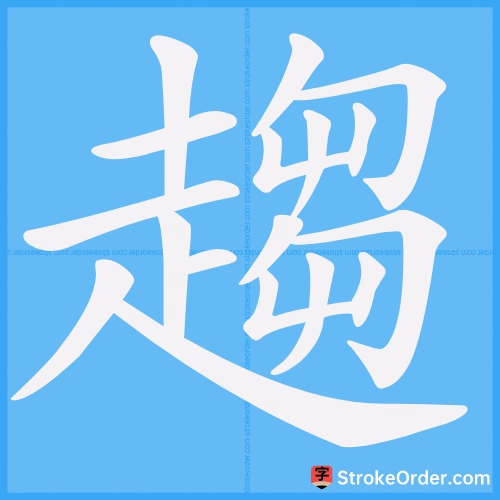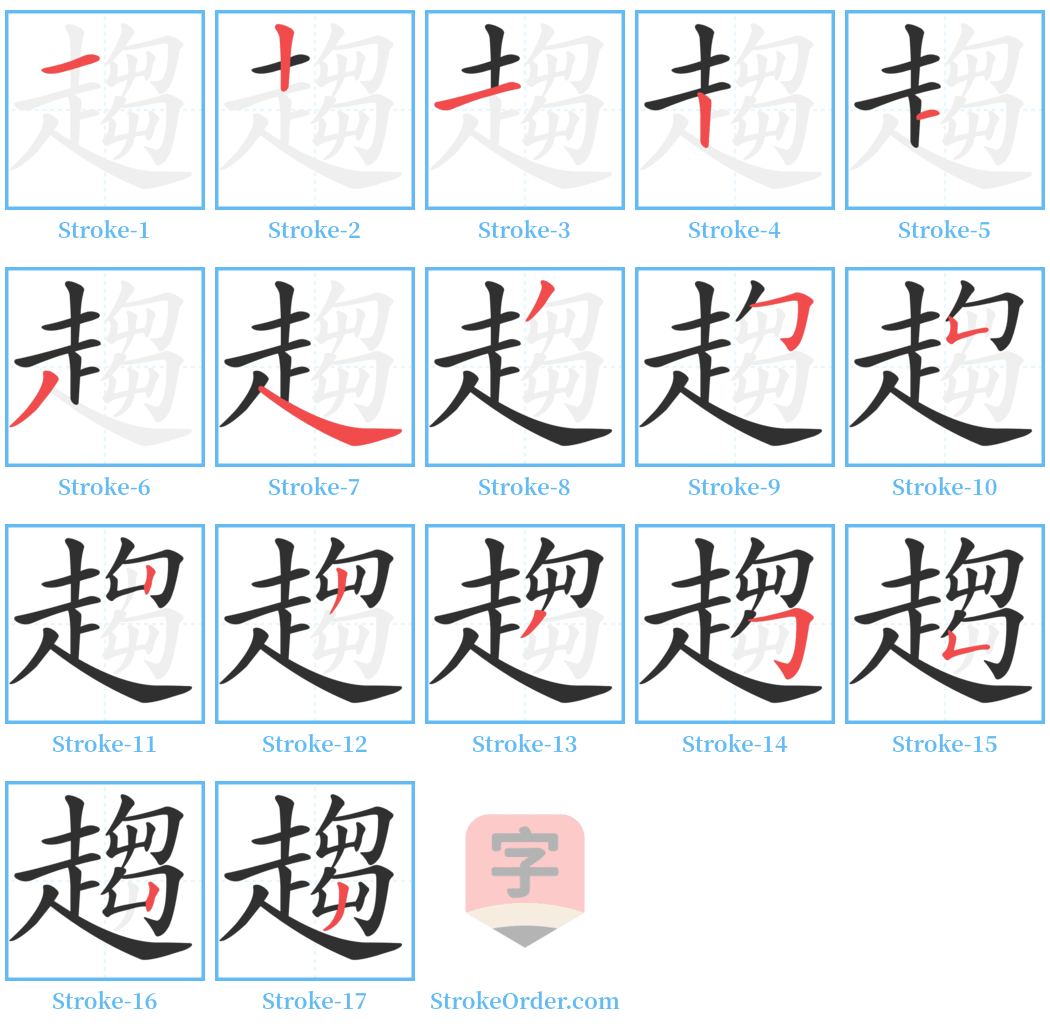趨 Stroke Order
Animated Stroke Order of 趨

Stroke Order Diagrams for 趨

Step-by-Step Handwriting Guide for 趨

Learn to Write Chinese Characters with Video Tutorials
Watch the video of writing the Chinese character "趨", learn the correct stroke order (笔顺) of the character "趨", and master the standard way of writing the character "趨".
Free Printable Handwriting Practice with Stroke Order: 趨
Printable Writing Practice Worksheet of "趨" in Portrait Orientation (Tian Zi Ge)

Printable Writing Practice Worksheet of "趨" in Landscape Orientation (Tian Zi Ge)

Information of 趨
Pinyin
qū、 cù
Radical
走
Strokes
17 strokes
Usage
★★★
Definition
to hasten / to hurry / walk fast
趨
1. To walk quickly, to hurry forward.
Example: "趨前" (hurry forward), "疾趨而過" (rush past). In "孟子•公孫丑上", it is stated: "其子趨而往視之" (His son hurried over to see). In "文選•陶淵明•雜詩二首之二": "日入群動息,歸鳥趨林鳴" (As the sun sets, all movement ceases; returning birds hurry to the forest and chirp).
2. To move towards a certain purpose or direction.
Example: "趨吉避凶" (seek fortune and avoid misfortune), "時勢所趨" (the trend of the times), "趨於一致" (move towards consensus). In "文選•王•四子講德論": "今夫子閉門距躍,專精趨學有日矣!" (Now the master closes the door, concentrates on study, and will surely achieve results!).
3. To attach or adhere to.
Example: "趨炎附勢" (to follow the powerful). In "荀子•議兵": "韓之上地,方數百里,完全富足而趨趙" (The land of Han, hundreds of miles wide, is rich and affluent and therefore inclined towards Zhao).
4. A small, quick step forward in ancient etiquette when wanting to pass an elder.
In "論語•微子": "趨而辟之,不得與之言" (Quickly stepping forward, I tried to avoid him, but he wouldn’t speak to me). In "唐•柳宗元《植靈壽木詩》": "前趨問長老,重復欣嘉名" (I hurried ahead to ask the elder, repeatedly praising his name).
5. Direction or orientation.
Example: "志趨" (aspirations). In "孟子•告子下": "三子者不同道,其趨一也。一者何也?曰仁也" (The three sons have different paths, but their direction is the same. What is it? It is benevolence).
Verb: To walk quickly, to hurry forward. Example: "趋前" (hurry forward), "疾趋而过" (rush past). In "孟子•公孙丑上": "其子趋而往视之" (His son hurried over to see). In "文选•陶渊明•杂诗二首之二": "日入群动息,归鸟趋林鸣" (As the sun sets, all movement ceases; returning birds hurry to the forest and chirp).
Verb: To move towards a certain purpose or direction. Example: "趋吉避凶" (seek fortune and avoid misfortune), "时势所趋" (the trend of the times), "趋于一致" (move towards consensus). In "文选•王襃•四子讲德论": "今夫子闭门距跃,专精趋学有日矣!" (Now the master closes the door, concentrates on study, and will surely achieve results!).
1. Also means "促" (to urge or hasten).
通“促”.
通「促」.
通「促」.